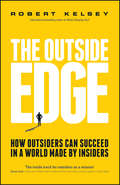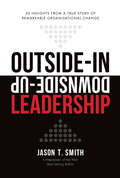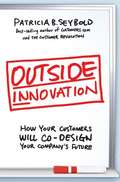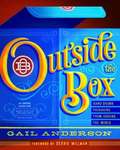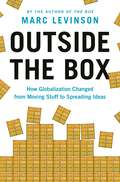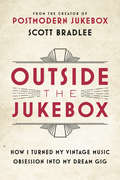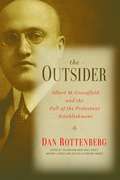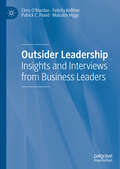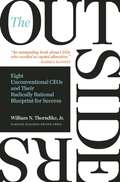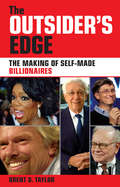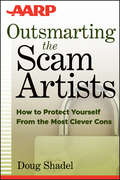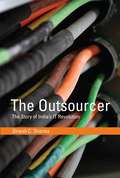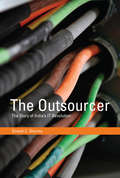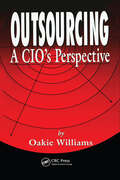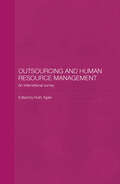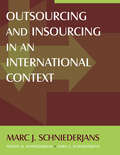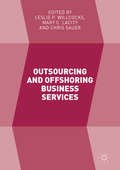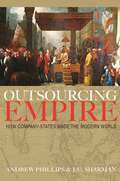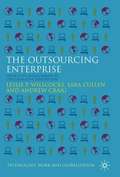- Table View
- List View
The Outside Edge: How Outsiders Can Succeed in a World Made by Insiders
by Robert KelseyThe brand new book from the international bestselling self-help author Robert Kelsey's internationally bestselling self-help books have helped tens of thousands of people overcome fear of failure and under confidence. Now Robert is back and is here to debunk the ever pervasive myths around the trail-blazing rebel outsider.... Our culture celebrates outsiders while – in reality – slamming the door in their face. The modern world craves innovation while alienating original thinkers. It encourages creativity while shutting-out all but a privileged few from individualistic expression. What a waste! Yet achieving great things as a genuine outsider is possible. Outsiders can find their own way – succeeding without compromising their individuality. They just need to forge an edge. The Outside Edge is all about learning to harness the unique vantage point you possess in order to give yourself the edge required to succeed. It will show you when to embrace your outsider status and go against convention, and when to play the game, do as the insiders do and make sure you can get progress. Think of The Outside Edge as a manual for positively directing your insecurity, awkwardness and role-confusion – towards a meaningful future, shaped and pursued on your own terms. By getting The Outside Edge you can: Identity and understand the causes of feeling like an "outsider" Accept yourself while focusing on "finding meaning" for your life Motivate yourself using strong goals, often harnessing creativity Acquire the skills needed to succeed on your own terms Avoid pitfalls such as poor judgement, negativity and extremism.
Outside-In Downside-Up Leadership: 50 insights from a remarkable true story of organisational change
by Jason T SmithFor more than a decade, Jason T. Smith had led his business with a traditional vertical organisational structure that mostly worked – up to a point, anyway. But something changed. He set an unreasonable goal that couldn't be achieved through the status quo. The organisational model lacked the critical design attributes needed to unleash its innovative potential. It seemed like the team had just stopped working.Fast-forward two years later, after weeks of intentional learning, planning, testing and probing, they found the sweet spot between collaboration and peer accountability. They discovered an authentic and scalable way to give each team member the freedom to do what they love and excel at it. They started working from the outside-in, turning former norms and systems downside-up.The result was a workplace revolution. They achieved their overriding strategic target of 7/50/100: a brand presence in 7 states or territories, generating revenues of close to $50 million in annual client services, in over 100 locations. The colleagues leading the organisation work together in their new- found structure they call ONEteam™.This book is their story... warts and all!
Outside Innovation
by Patricia B. SeyboldHow dynamic businesses of every size can unleash innovation by inviting customers to co-design what they do and make. Reading line: The 8 Roles Customers Play in Trend-Setting Companies The refrain is familiar for Patricia Seybold in her journeys as a top technology and management strategist: "I want our company to be acknowledged as the most admired and most customer-valued in our industry and to be recognized as the company that has forever changed the way things are done." "How can we become the Google of banking?" "How can we be the eBay of software?" "I want to be the JetBlue of manufacturing." "How can we become the undisputed trend-setter in our industry-with a competitive bar no one can topple?" In Outside Innovation, bestselling author Seybold taps her close relationship with dozens of high-innovation companies to reveal the untold strategy behind the trendsetters and the next HUGE leap forward in customer strategy. Seybold shows that companies that are dominating their category and staying ahead of the pack are collaborating at every level of their business with their customers.
Outside Sources: Sensing Opportunities Externally--Innovation Tournaments Require More--and Better--Ideas
by Karl T. Ulrich Christian TerwieschInnovators work inside big established firms and in start-ups to improve their firms' competitive prospects. But opportunities for innovation also bubble up outside firms in places like university labs and hobbyists' garages. Thus, in addition to generating opportunities internally, innovation firms must also sense them externally. This chapter will help you do that by showing you how to understand when externally generated opportunities matter most and how to set up sensing mechanisms to help you identify them. This chapter was originally published as chapter 3 of "Innovation Tournaments: Creating and Selecting Exceptional Opportunities."
Outside the Box
by Gail AndersonIn an age of slick, computer-generated type and Photoshopped perfection, hand-drawn packing is enjoying a global resurgence. As shorthand for something more authentic, homegrown, handmade, or crafted, hand-drawn packaging is found on everything from supermarket eggs to Chipotle drink cups. In this exhaustive and lavishly illustrated survey, organized by four types--DIY, art, craft, and artisanal--Gail Anderson pulls back the curtain on the working processes and inspirations of forty letterers, illustrators, and designers from all around the world through insightful interviews, process sketches, and her infectious love of the medium.
Outside the Box: How Globalization Changed from Moving Stuff to Spreading Ideas
by Marc LevinsonFrom the acclaimed author of The Box, a new history of globalization that shows us how to navigate its futureGlobalization has profoundly shaped the world we live in, yet its rise was neither inevitable nor planned. It is also one of the most contentious issues of our time. While it may have made goods less expensive, it has also sent massive flows of money across borders and shaken the global balance of power. Outside the Box offers a fresh and lively history of globalization, showing how it has evolved over two centuries in response to changes in demography, technology, and consumer tastes.Marc Levinson, the acclaimed author of The Box, tells the story of globalization through the people who eliminated barriers and pursued new ways of doing business. He shows how the nature of globalization changed dramatically in the 1980s with the creation of long-distance value chains. This new type of economic relationship shifted manufacturing to Asia, destroying millions of jobs and devastating industrial centers in North America, Europe, and Japan. Levinson describes how improvements in transportation, communications, and computing made international value chains possible, but how globalization was taken too far because of large government subsidies and the systematic misjudgment of risk by businesses. As companies began to account properly for the risks of globalization, cross-border investment fell sharply and foreign trade lagged long before Donald Trump became president and the coronavirus disrupted business around the world.In Outside the Box, Levinson explains that globalization is entering a new era in which moving stuff will matter much less than moving services, information, and ideas.
Outside the Box
by Jeannie MarshallA lively, cross-cultural look at the way packaged and fast foods are marketed to our kids--and a meditation on how our eating habits and our family lives are being changed in the process. When Canadian journalist Jeannie Marshall moved to Rome with her husband, she delighted in Italy's famous culinary traditions. But when Marshall gave birth to a son, she began to see how that food culture was eroding, especially within young families. Like their North American counterparts, Italian children were eating sugary cereal in the morning and packaged, processed, salt- and fat-laden snacks later in the day. Busy Italian parents were rejecting local markets for supermercati, and introducing their toddlers to fast food restaurants only too happy to imprint their branding on the youngest of customers. So Marshall set on a quest to discover why something that we can only call "kid food" is proliferating around the world. How did we develop our seemingly insatiable desire for packaged foods that are virtually devoid of nutrition? How can even a mighty food culture like Italy's change in just a generation? And why, when we should and often do know better, do we persist in filling our children's lunch boxes, and young bodies, with ingredients that can scarcely even be considered food? Through discussions with food crusaders such as Alice Waters, with chefs in Italy, nutritionists, fresh food vendors and parents from all over, and with big food companies such as PepsiCo and Nestle, Marshall gets behind the issues of our children's failing nutrition and serves up a simple recipe for a return to real food.From the Hardcover edition.
Outside the Jukebox: How I Turned My Vintage Music Obsession into My Dream Gig
by Scott BradleeFrom the creator of the sensation Postmodern Jukebox--with millions of fans globally--comes an inspirational memoir about discovering what you love and turning it into a creative movement. With student loan debt piling up and no lucrative gigs around the corner, Scott Bradlee found himself in a situation all too familiar to struggling musicians and creative professionals, unsure whether he should use the little income he had to pay the rent on his basement apartment on the fringes of New York City or to avoid defaulting on his loans. It was under these desperate circumstances that Bradlee began experimenting, applying his passion for jazz, ragtime, and doo wop styles to contemporary hits by singers like Macklemore and Miley Cyrus--and suddenly an idea was born. The bands Bradlee went on to launch--from A Motown Tribute to Nickelback to Postmodern Jukebox, the rotating supergroup devoted to period covers of pop songs for which he is best known--borrowed from and refined the initial idea he had arrived at to bring genres now sometimes considered arcane to wide audiences. Today, the success he has had is astonishing, with Postmodern Jukebox collecting upwards of three million subscribers on YouTube, selling out major venues around the world, and developing previously unknown talent into superstar singers. Taking readers through the false starts, absurd failures, and unexpected breakthroughs of Bradlee's journey from a lost musician to a musical kingmaker headlining Radio City Music Hall--and presenting all the insights he learned along the way to becoming an entrepreneur like no other--OUTSIDE THE JUKEBOX is an inspiring memoir about how one musician found his rhythm and launched a movement that would forever change how people make, distribute, and enjoy their favorite songs.
The Outsider: Albert M. Greenfield and the Fall of the Protestant Establishment
by Dan Rottenberg"Albert M. Greenfield (1887-1967), an ambitious immigrant outsider, was courted for his business acumen by mayors, senators, governors, and presidents, including Franklin Roosevelt and Harry Truman. As this feisty Russian Jew built a business empire that encompassed real estate, stores (including Bonwit Teller and Tiffany's), hotels (including the Ben Franklin and the Bellevue-Stratford), banks, newspapers, transportation companies, and even the Loft Candy Corporation, he challenged the entrenched business elite. Greenfield was also instrumental in bringing both major political conventions to Philadelphia in 1948. In The Outsider, veteran journalist and best-selling author Dan Rottenberg deftly chronicles the astonishing rises, falls, and countless reinventions of this savvy businessman. Greenfield's power allowed him to cross social, religious, and ethnic boundaries with impunity. He alarmed Philadelphia's conservative business and social leaders-Christians and Jews alike-some of whom plotted his downfall. In this engaging account of Greenfield's fascinating life, Rottenberg demonstrates the extent to which one uniquely brilliant and energetic man pushed the boundaries of society's limitations on individual potential. The Outsider provides a microcosmic look at three twentieth-century upheavals: the rise of Jews as a crucial American business force, the decline of America's Protestant establishment, and the transformation of American cities"--
The Outsider Advantage: Because You Don't Need to Fit in to Win
by Ciera RogersFrom the fashion mogul and entrepreneur behind Babes, an empowering memoir about turning what makes you different into the foundation of your successCiera Rogers is known for being an &“Outsider&”—and she likes it that way. As the founder and CEO of a multi-million-dollar brand that caters to curvy women of all shades, worn by the likes of Kim Kardashian and championed by Beyoncé, Ciera has rallied the very women the fashion industry is designed to ignore around the radical idea that what makes you different is actually your superpower.The Outsider Advantage is for Outsiders like her: the dreamers, doers, and go-getters that society continuously overlooks and underestimates, but who are uniquely equipped to achieve glass-shattering success.In this bold and inspiring memoir, Ciera shares the moments in her life that left the biggest impact—being kidnapped at a young age by her estranged father, running hustles in strip clubs, living in her mom&’s red Jeep, daring to post her first outfit for sale on Instagram, hitting seven-figures, and buying a home—and unearths the powerful lessons she has taken away from her past and her unorthodox rise, like how to harness what you already have and how to use your trauma as a motivator. She also speaks to feelings of millennial rage, as on her journey, she came to realize that the American Dream is a lie. But she didn&’t allow that to stop her from outmaneuvering the system to finally live the life she wanted.Arguing that what the world calls limitations—lack of connections, resources, fancy degrees, or even the &“right&” look—are actually our biggest competitive advantages, Ciera teaches anyone who has ever been overlooked, ignored or underestimated how to embrace their Outsider status to find unstoppable success.
Outsider Leadership: Insights and Interviews from Business Leaders
by Chris O'Riordan Felicity Kelliher Patrick C. Flood Malcolm HiggsEncompassing interviews with managing directors and CEOs, this book explores the role of business outsiders as leaders. Viewing the term ‘outsider’ in a broad sense, the book considers leader background, perspective, gender, training and family membership and examines the implications, challenges and benefits brought by outsider leaders to their respective business environments. The authors explore questions and themes such as how outsider leaders can enrich an organisation, the importance of relationships and adopting a ‘hybrid’ approach, illuminated by interviewee perspectives. Introducing discussion and analysis through these narratives, Outsider Leadership distils commonalities to frame understanding of their experiences.
The Outsiders: Eight Unconventional CEOs and Their Radically Rational Blueprint for Success
by William N. ThorndikeWhat makes a successful CEO? Most people call to mind a familiar definition: “a seasoned manager with deep industry expertise.” Others might point to the qualities of today’s so-called celebrity CEOs—charisma, virtuoso communication skills, and a confident management style. But what really matters when you run an organization? What is the hallmark of exceptional CEO performance? Quite simply, it is the returns for the shareholders of that company over the long term. <p><p> In this refreshing, counterintuitive book, author Will Thorndike brings to bear the analytical wisdom of a successful career in investing, closely evaluating the performance of companies and their leaders. You will meet eight individualistic CEOs whose firms’ average returns outperformed the S&P 500 by a factor of twenty—in other words, an investment of $10,000 with each of these CEOs, on average, would have been worth over $1.5 million twenty-five years later. You may not know all their names, but you will recognize their companies: General Cinema, Ralston Purina, The Washington Post Company, Berkshire Hathaway, General Dynamics, Capital Cities Broadcasting, TCI, and Teledyne. In The Outsiders, you’ll learn the traits and methods—striking for their consistency and relentless rationality—that helped these unique leaders achieve such exceptional performance. <p> Humble, unassuming, and often frugal, these “outsiders” shunned Wall Street and the press, and shied away from the hottest new management trends. Instead, they shared specific traits that put them and the companies they led on winning trajectories: a laser-sharp focus on per share value as opposed to earnings or sales growth; an exceptional talent for allocating capital and human resources; and the belief that cash flow, not reported earnings, determines a company’s long-term value. <p> Drawing on years of research and experience, Thorndike tells eye-opening stories, extracting lessons and revealing a compelling alternative model for anyone interested in leading a company or investing in one—and reaping extraordinary returns.
The Outsider's Edge
by Brent D. TaylorThe secret of extreme wealth creationThe Outsider's Edge reveals the one common denominator the world's richest self-made people share. Studying the lives of 17 world-famous billionaires, author and researcher Brent Taylor discovered that their one shared experience is that of the outsider. From Bill Gates to Richard Branson to Warren Buffett, being different from their peers, and proud of it, has served as prime motivation for many of the world's most spectacularly successful people. Turning the conventional wisdom about wealth on its head, The Outsider's Edge reveals the true value and importance of being different.Brent Taylor (Australia) is a professional researcher who has worked for more than 20 years as a market researcher to government and corporations.
Outsmarting the Scam Artists: How to Protect Yourself From the Most Clever Cons
by D. ShadelA practical guide to avoiding the most common scams, from a fraud-fighting expert U.S. consumers lose billions of dollars each year to scam artists—and the next victim could be you. While anyone can be targeted, many victims are older. In AARP's Outsmarting the Scam Artists, renowned fraud-fighter Doug Shadel offers practical advice for consumers who want to protect their money as well as the financial assets of their parents and families. Despite the rise of scams, many people are embarrassed to admit they've been victimized. The author helps break the cycle of shame by including accounts from the people who've been scammed as well as tips from a surprising source: convicted con artists who reveal how they've defrauded people like you. Get practical tips to combat all kinds of scams, from simple lottery tickets to non-existent oil and gas deals and religious ponzi schemes Learn how to protect yourself by securing your mailbox and fraud-proofing your trash Get inside the head of sophisticated scam artists to discover how you can become the type of individual they avoid Scammers are everywhere. But with Outsmarting the Scam Artists in hand, you can protect yourself and your money.
The Outsourcer
by Dinesh C. SharmaThe rise of the Indian information technology industry is a remarkable economic success story. Software and services exports from India amounted to less than $100 million in 1990, and today come close to $100 billion. But, as Dinesh Sharma explains in The Outsourcer, Indian IT's success has a long prehistory; it did not begin with software support, or with American firms' eager recruitment of cheap and plentiful programming labor, or with India's economic liberalization of the 1990s. The foundations of India's IT revolution were laid long ago, even before the country's independence from British rule in 1947, as leading Indian scientists established research institutes that became centers for the development of computer science and technology. The "miracle" of Indian IT is actually a story about the long work of converting skills and knowledge into capital and wealth. With The Outsourcer, Sharma offers the first comprehensive history of the forces that drove India's IT success.Sharma describes India's early development of computer technology, part of the country's efforts to achieve national self-sufficiency, and shows that excessive state control stifled IT industry growth before economic policy changed in 1991. He traces the rise and fall (and return) of IBM in India and the emergence of pioneering indigenous hardware and software firms. He describes the satellite communication links and state-sponsored, tax-free technology parks that made software-related outsourcing by foreign firms viable, and the tsunami of outsourcing operations at the beginning of the new millennium. It is the convergence of many factors, from the tradition of technical education to the rise of entrepreneurship to advances in communication technology, that have made the spectacular growth of India's IT industry possible.
The Outsourcer: The Story of India's IT Revolution (History of Computing)
by Dinesh C. SharmaA history of how India became a major player in the global technology industry, mapping technological, economic, and political transformations. The rise of the Indian information technology industry is a remarkable economic success story. Software and services exports from India amounted to less than $100 million in 1990, and today come close to $100 billion. But, as Dinesh Sharma explains in The Outsourcer, Indian IT's success has a long prehistory; it did not begin with software support, or with American firms' eager recruitment of cheap and plentiful programming labor, or with India's economic liberalization of the 1990s. The foundations of India's IT revolution were laid long ago, even before the country's independence from British rule in 1947, as leading Indian scientists established research institutes that became centers for the development of computer science and technology. The “miracle” of Indian IT is actually a story about the long work of converting skills and knowledge into capital and wealth. With The Outsourcer, Sharma offers the first comprehensive history of the forces that drove India's IT success.Sharma describes India's early development of computer technology, part of the country's efforts to achieve national self-sufficiency, and shows that excessive state control stifled IT industry growth before economic policy changed in 1991. He traces the rise and fall (and return) of IBM in India and the emergence of pioneering indigenous hardware and software firms. He describes the satellite communication links and state-sponsored, tax-free technology parks that made software-related outsourcing by foreign firms viable, and the tsunami of outsourcing operations at the beginning of the new millennium. It is the convergence of many factors, from the tradition of technical education to the rise of entrepreneurship to advances in communication technology, that have made the spectacular growth of India's IT industry possible.
Outsourcing
by Michael J. MolOutsourcing has become one of the key restructuring tools for companies seeking to boost their growth and business performance. As the outsourcing phenomenon has mushroomed, so a range of academic studies have sought to define and describe a unifying theoretical model. Outsourcing: Design, Process and Performance draws upon managerial, economic, sociological, historical and psychological perspectives to bring about a new understanding of how outsourcing design and the outsourcing process feed into the performance of firms. Blending empirical insights from a range of international cases and large-scale statistical tests with existing theoretical perspectives, the author argues that a negative curvilinear relationship exists between outsourcing and firm performance. A critical analysis of current outsourcing strategies, together with a discussion of future trends, offers a new agenda for academic researchers and business managers alike.
Outsourcing: A CIO's Perspective
by Oakie D. WilliamsAs global competition grows more fierce, companies continue to look for ways to increase their competitive edge without jeopardizing profit margins. Today's corporations are starting to realize the competitive advantage that Information Technology (IT) can bring to a company. These corporations are also realizing that staying current with technology requires a great deal of effort, risk, and expense. This is one of the primary reasons CEO's are considering outsourcing as an alternative.Written by a CIO who has successfully maneuvered through the outsourcing process, Outsourcing: A CIO's Perspective addresses the realistic expectations and the most commonly asked questions about IT outsourcing, while reviewing it's advantages and disadvantages. This text identifies key elements that can be used to assess the feasibility of securing a profitable and manageable outsourcing agreement. It provides a convincing case that even if the final decision is to not outsource, the result of the process will identify potential business improvement opportunities.
Outsourcing and Human Resource Management: An International Survey (Routledge Studies in the Growth Economies of Asia)
by Ruth TaplinOutsourcing is an increasingly popular strategy deployed by a variety of institutions, including banks, multinational companies and small and medium-sized enterprises (SMEs). The book assesses the problems and solutions for those attempting to outsource through an analysis of human resource management, insourcing, lifecycles of the project, insurance requirements, operational management and recruitment within the context of the financial services industry, automotive and IT industries of Japan, North and South Korea, South Africa, Mexico, Eastern Europe, China and India. Including detailed comparative case studies, this book: considers how outsourcing can best be made to work explores the human side of outsourcing offers practical advice for improving organizational relationships and performance looks at important practices such as insourcing provides much needed analysis of the risk and insurance issues involved in outsourcing.
Outsourcing and Insourcing in an International Context
by Marc J Schniederjans Ashlyn M Schniederjans Dara G SchniederjansDesigned for upper-level undergraduate or graduate courses in production-operations management, management information systems, international business, and strategic management, this text focuses on concepts, processes, and methodologies for firms planning to undertake or currently involved in outsourcing-insourcing decisions. "Outsourcing and Insourcing in an International Context" is the only available text that includes coverage of the international risk factors associated with this strategy. The book presents a balanced view of the positive and negative aspects of outsourcing, and provides essential coverage of the fundamental techniques involved in any outsourcing-insourcing decision. In addition, it discusses the ethical ramifications of outsourcing for companies and governments around the world. Each chapter includes learning objectives, discussion questions, and sample problems. An Instructor's Manual, Test Bank, and PowerPoint presentation are available to teachers who adopt the text.
Outsourcing and Offshoring Business Services
by Leslie P. Willcocks Mary C. Lacity Chris SauerBringing together theoretical and empirical studies from the Journal of Information Technology, this book provides a definitive guide to research discovered on the growing global sourcing phenomenon. Paying particular attention to Information Technology Outsourcing (ITO) and Business Process Outsourcing (BPO), theoretical chapters explore insightful ways of thinking about the different facets of outsourcing, and provide useful information to practitioners and researchers. Empirical chapters report the findings of 405 major research studies into the risks and successes of relationships between customer and vendor, the development of trust in these relationships, the factors affecting locations for offshoring, and specialized offshoring organizations such as captive centres. In this comprehensive study, the editors present an expert review of the historical development of this field, and offer analysis of emerging findings and practices for the future.
Outsourcing and the Virtual Organization: The Incredible Shrinking Company
by Jim DurcanIncreasingly, companies are buying in from outside certain services and functions that would previously have been fulfilled by an internal department or employees. Companies no longer just outsource support functions, but also outsource critical areas of production or design. It lets companies focus on those activities where they have real competitive edge, and is increasingly being seen as an attractive alternative to downsizing or cost-cutting.Durcan and Oates provide a wide-ranging expert overview of outsourcing, aimed at managers and decision-makers who want to understand fully all the issues involved. How do companies define core and non-core activities? How do you find the best provider of an outsourced function? What are the pitfalls to avoid? How do you monitor the service provider? What is the impact on issues such as corporate security and confidentiality? The authors also consider how outsourcing is redefining the nature of corporations: if companies have minimal physical existence, but exist as a network of relationships and contracts, when should we speak of the 'virtual organisation'?
Outsourcing Economics
by William Milberg Deborah WinklerOutsourcing Economics has a double meaning. First, it is a book about the economics of outsourcing. Second, it examines the way that economists have understood globalization as a pure market phenomenon, and as a result have 'outsourced' the explanation of world economic forces to other disciplines. Markets are embedded in a set of institutions - labor, government, corporate, civil society, and household - that mold the power asymmetries that influence the distribution of the gains from globalization. In this book, William Milberg and Deborah Winkler propose an institutional theory of trade and development starting with the growth of global value chains - international networks of production that have restructured the global economy and its governance over the past twenty-five years. They find that offshoring leads to greater economic insecurity in industrialized countries that lack institutions supporting workers. They also find that offshoring allows firms to reduce domestic investment and focus on finance and short-run stock movements. Economic development has become synonymous with 'upgrading' in global value chains, but this is not sufficient for improved wages or labor standards, raising obstacles to sustained economic development for many emerging economies.
Outsourcing Empire: How Company-States Made the Modern World
by Professor Andrew Phillips J C SharmanHow chartered company-states spearheaded European expansion and helped create the world’s first genuinely global orderFrom Spanish conquistadors to British colonialists, the prevailing story of European empire-building has focused on the rival ambitions of competing states. But as Outsourcing Empire shows, from the seventeenth to the twentieth centuries, company-states—not sovereign states—drove European expansion, building the world’s first genuinely international system. Company-states were hybrid ventures: pioneering multinational trading firms run for profit, with founding charters that granted them sovereign powers of war, peace, and rule. Those like the English and Dutch East India Companies carved out corporate empires in Asia, while other company-states pushed forward European expansion through North America, Africa, and the South Pacific. In this comparative exploration, Andrew Phillips and J. C. Sharman explain the rise and fall of company-states, why some succeeded while others failed, and their role as vanguards of capitalism and imperialism.In dealing with alien civilizations to the East and West, Europeans relied primarily on company-states to mediate geographic and cultural distances in trade and diplomacy. Emerging as improvised solutions to bridge the gap between European rulers’ expansive geopolitical ambitions and their scarce means, company-states succeeded best where they could balance the twin imperatives of power and profit. Yet as European states strengthened from the late eighteenth century onward, and a sense of separate public and private spheres grew, the company-states lost their usefulness and legitimacy.Bringing a fresh understanding to the ways cross-cultural relations were handled across the oceans, Outsourcing Empire examines the significance of company-states as key progenitors of the globalized world.
The Outsourcing Enterprise
by Leslie P. Willcocks Sara Cullen Andrew CraigEvidence shows that organizations with both a CEO and a team involved in sourcing strategy and supplier configuration make more effective decisions. If the wrong supplier is chosen, performance can be negatively affected. Here the authors look at how companies can improve their outsourcing capabilities.
